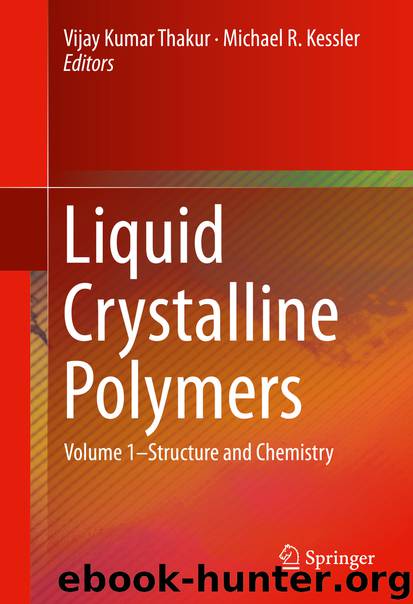Liquid Crystalline Polymers by Vijay Kumar Thakur & Michael R. Kessler

Author:Vijay Kumar Thakur & Michael R. Kessler
Language: eng
Format: epub
Publisher: Springer International Publishing, Cham
9.3.2 Polarized Light Microscopy
PLM is a widely used technique to study and identify the phases exhibited by LCs. A thin layer of a LC is placed in between two cover glass plates and viewed through a PLM under temperature or proper conditions depending on the type of LC phase, various textures can be observed. Beautiful kaleidoscopic images called textures are seen due to the interference between light waves passing through the specimen, which is already heavily given throughout the chapter.
The formation and growth of LCs in nanocellulose was observed by means of laser diffraction. The laser beam produces a diffraction pattern and the central spot of the ring grows into a steady circular ring showing the growth of LCs and their organization into larger assemblies which is confirmed by the appearance of concentric rings after some time. Optical microscopy is an important tool for the study of the structure of lamellar LCs. Many microscopic techniques like SEM, TEM and AFM are commonly used. Chiral nematic phases have been observed for concentrated solutions and melts of many cellulose derivatives (Gray 1995). Both left and right-handed solutions, melts and films have been observed for cellulose derivatives, but to date only left-handed helicoids have been observed for CNC suspensions and films. The assignment of handedness was based on TEM images of oblique microtomed sections of films cast from aqueous suspensions of CNCs, following the interpretation of the arcing observed in natural composites by Bouligand (2008). Arcing observed in TEM images of thin oblique cross-sections through a planar chiral nematic film of wood CNCs cast from aqueous suspension on a Teflon substrate is shown in Fig. 9.20 (Giasson 1995).
Fig. 9.20Arcing observed in TEM images of thin oblique cross-sections through a planar chiral nematic film of wood CNCs cast from aqueous suspension on a Teflon substrate. The sections were cut at angles such that the top left-hand corner of the image was tilted (a) towards and (b) away from the observer (Giasson 1995) (Reproduced with permission from Dissertation, McGill University, Chap. 5, p 167)
Download
This site does not store any files on its server. We only index and link to content provided by other sites. Please contact the content providers to delete copyright contents if any and email us, we'll remove relevant links or contents immediately.
Alchemy and Alchemists by C. J. S. Thompson(3416)
The Elements by Theodore Gray(2947)
The Club by A.L. Brooks(2805)
How to Make Your Own Soap by Sally Hornsey(2786)
Drugs Unlimited by Mike Power(2509)
Wheels of Life by Anodea Judith(1947)
Cracking the Sat French Subject Test, 2013-2014 Edition by The Princeton Review(1797)
Perfume by Jean-Claude Ellena(1759)
Cracking the LSAT, 2012 Edition by Princeton Review(1755)
The Flavor Matrix by James Briscione(1735)
The Cosmic Machine: The Science That Runs Our Universe and the Story Behind It by Scott Bembenek(1707)
MCAT Physics and Math Review by Princeton Review(1603)
1000 Multiple-Choice Questions in Organic Chemistry by Organic Chemistry Academy(1584)
The Thing Around Your Neck by Chimamanda Ngozi Adichie(1539)
Handbook of Modern Sensors by Jacob Fraden(1517)
Cracking the SAT Premium Edition with 6 Practice Tests, 2017 by Princeton Review(1498)
Synchrotron Light Sources and Free-Electron Lasers by Eberhard J. Jaeschke Shaukat Khan Jochen R. Schneider & Jerome B. Hastings(1497)
A is for Arsenic: The Poisons of Agatha Christie (Bloomsbury Sigma) by Kathryn Harkup(1474)
Harry Potter All Books: 8 Books by J.k.rowling(1454)
